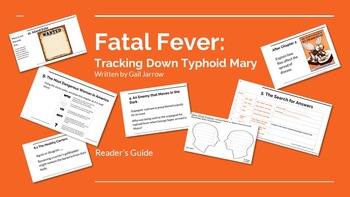Fatal Fever: Tracking Down Typhoid Mary Reader's Guide
Organic Literacy
63 Followers
Grade Levels
7th - 10th
Subjects
Resource Type
Standards
CCSSRI.7.1
CCSSRI.7.10
CCSSRI.8.1
CCSSRI.8.10
CCSSRI.9-10.1
Formats Included
- Zip
Pages
45 pages
Organic Literacy
63 Followers
Description
Gail Jarrow has written an engaging account of the search for the source of the typhoid fever outbreak in 1907. This is the reader's guide and supplementary materials that I used with my students while we read this book.
Students were asked to find evidence in the text, use timelines, identify arguments of opposing individuals and define words using context clues. This book will fit easily into any life science class or English Language Arts class. In addition, this product works very easily with a DVD which I was able to find at my local library called Typhoid Mary: The Most Dangerous Woman in America.
The product file contains a reader's guide with answers and two comprehension quizzes with answer keys.
The reader's guide is a powerpoint which can be edited, and the quizzes are pdf files.
Students were asked to find evidence in the text, use timelines, identify arguments of opposing individuals and define words using context clues. This book will fit easily into any life science class or English Language Arts class. In addition, this product works very easily with a DVD which I was able to find at my local library called Typhoid Mary: The Most Dangerous Woman in America.
The product file contains a reader's guide with answers and two comprehension quizzes with answer keys.
The reader's guide is a powerpoint which can be edited, and the quizzes are pdf files.
Total Pages
45 pages
Answer Key
Included
Teaching Duration
2 Weeks
Report this resource to TPT
Reported resources will be reviewed by our team. Report this resource to let us know if this resource violates TPT’s content guidelines.
Standards
to see state-specific standards (only available in the US).
CCSSRI.7.1
Cite several pieces of textual evidence to support analysis of what the text says explicitly as well as inferences drawn from the text.
CCSSRI.7.10
By the end of the year, read and comprehend literary nonfiction in the grades 6–8 text complexity band proficiently, with scaffolding as needed at the high end of the range.
CCSSRI.8.1
Cite the textual evidence that most strongly supports an analysis of what the text says explicitly as well as inferences drawn from the text.
CCSSRI.8.10
By the end of the year, read and comprehend literary nonfiction at the high end of the grades 6–8 text complexity band independently and proficiently.
CCSSRI.9-10.1
Cite strong and thorough textual evidence to support analysis of what the text says explicitly as well as inferences drawn from the text.





